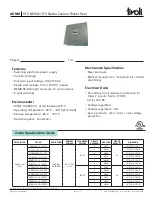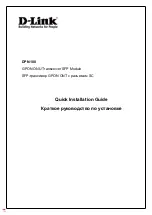
IM 01C25F01-01E
2-5
2. HANDLING CAUTIONS
Note 3. Operation
• Keep the “WARNING” nameplate attached to the
transmitter.
WARNING: OPEN CIRCUIT BEFORE REMOV-
ING COVER. FACTORY SEALED, CONDUIT
SEAL NOT REQUIRED. INSTALL IN ACCOR-
DANCE WITH THE USERS MANUAL IM
01C25.
• Take care not to generate mechanical sparking
when accessing to the instrument and peripheral
devices in a hazardous location.
Note 4. Maintenance and Repair
• The instrument modification or parts replacement
by other than authorized representative of
Yokogawa Electric Corporation is prohibited and
will void Factory Mutual Explosionproof Approval.
c. FM Intrinsically Safe Type/FM
Explosionproof Type
Model EJX Series pressure transmitters with
optional code /FU1 can be selected the type of
protection (FM Intrinsically Safe or FM
Explosionproof) for use in hazardous locations.
Note 1. For the installation of this transmitter,
once a particular type of protection is
selected, any other type of protection
cannot be used. The installation must be
in accordance with the description about
the type of protection in this instruction
manual.
Note 2. In order to avoid confusion, unnecessary
marking is crossed out on the label other
than the selected type of protection when
the transmitter is installed.
2.9.2 CSA Certification
a. CSA Intrinsically Safe Type
Caution for CSA Intrinsically safe type. (Following
contents refer to “DOC No. ICS013-A13”)
Note 1. Model EJX Series differential, gauge, and
absolute pressure transmitters with
optional code /CS1 are applicable for use
in hazardous locations
Certificate: 1606623
[For CSA C22.2]
• Applicable Standard: C22.2 No.0, C22.2 No.0.4,
C22.2 No.25, C22.2 No.94, C22.2 No.157, C22.2
No.213, C22.2 No.1010.1
• Intrinsically Safe for Class I, Division 1, Groups A,
B, C & D, Class II, Division 1, Groups E, F & G,
Class III, Division 1
• Nonincendive for Class I, Division 2, Groups A, B,
C & D, Class II, Division 2, Groups E, F & G,
Class III, Division 1
• Enclosure: Type 4X,
• Temp. Code: T4
• Amb. Temp.:–50 to 60
°
C
• Process Temperature: 120
°
C max.
[For CSA E60079]
• Applicable Standard: CAN/CSA E60079-0,
CAN/CSA E60079-11, CAN/CSA E60079-15,
IEC 60529:2001-02
• Ex ia IIC T4, Ex nL IIC T4
• Ambient Temperature :–50 to 60
°
C
• Max. Process Temp.: 120
°
C
• Enclosure: IP66 and IP67
Note 2. Entity Parameters
• Intrinsically safe ratings are as follows:
Maximum Input Voltage (Vmax/Ui) = 30 V
Maximum Input Current (Imax/Ii) = 200 mA
Maximum Input Power (Pmax/Pi) = 0.9 W
Maximum Internal Capacitance (Ci) = 10 nF
Maximum Internal Inductance (Li) = 0
µ
H
• Type "n" or Nonincendive ratings are as follows:
Maximum Input Voltage (Vmax/Ui) = 30 V
Maximum Internal Capacitance (Ci) = 10 nF
Maximum Internal Inductance (Li) = 0
µ
H
• Installation Requirements
Uo
≤
Ui, Io
≤
Ii, Po
≤
Pi,
Co
≥
Ci + Ccable, Lo
≥
Li + Lcable
Voc
≤
Vmax, Isc
≤
Imax,
Ca
≥
Ci + Ccable, La
≥
Li + Lcable
Uo, Io, Po, Co, Lo, Voc, Isc, Ca and La are
parameters of barrier.
Note 3. Installation
• In any safety barreir used output current must be
limited by a resistor 'R' such that Io=Uo/R or
Isc=Voc/R.
• The safety barrier must be CSA certified.
• Input voltage of the safet barrier must be less than
250 Vrms/Vdc.
• Installation should be in accordance with Canadian
Electrical Code Part I and Local Electrical Code.
• Dust-tight conduit seal must be used when
installed in Class II and III environments.
• The instrument modification or parts replacement
by other than authorized representative of
Yokogawa Electric Corporation and Yokogawa
Corporation of America is prohibited and will void
Canadian Standards Intrinsically safe and
nonincendive Certification.













































